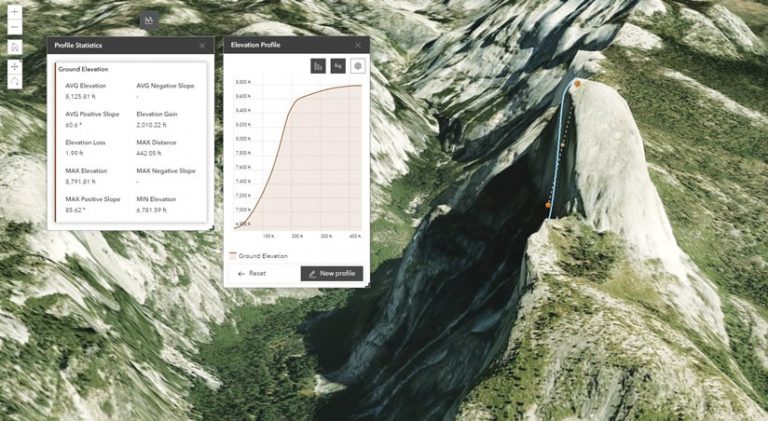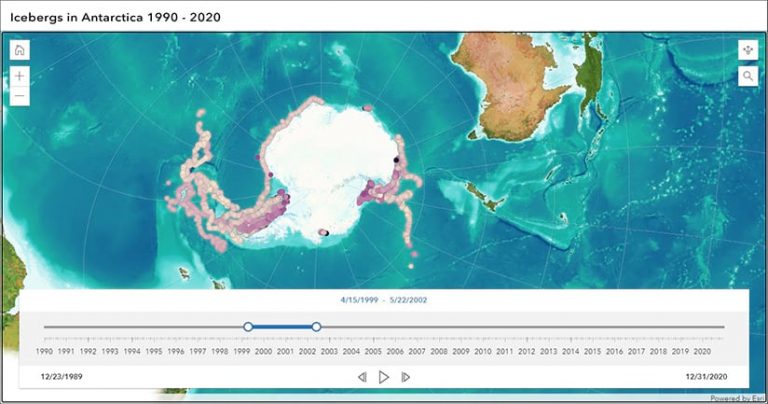The interactive web apps available in ArcGIS Online allow users to create engaging maps and apps to share spatial insight with their teams; communities; and, in some cases, people all over the world.
One of the great benefits of making web maps is that users can reuse their maps in many ways—for example, as the foundation for additional analysis or as the centerpiece of an experiential web app. And web apps help end users focus on the story that a map intends to tell. Some are also key for building digital workflows, even if those workflows aren’t mapcentric.
ArcGIS Online offers a growing set of web app configurations that help users deliver compelling and valuable digital experiences along with their maps. Several teams at Esri continually update the interactive web apps available in ArcGIS Online to provide users with the best and most modern app-building experiences. Here are highlights from recent releases of some of the most popular app builders in ArcGIS Online.
ArcGIS Dashboards
With ArcGIS Dashboards, users can present location-based analytics as intuitive and interactive data visualizations to help people monitor situations in real time, detect trends, and keep communities and teams informed. Recently, Esri added a Table element to Dashboards, allowing users to visualize their data in rows and columns. Tables support advanced formatting and data interactions so that, for example, when a user clicks a particular field, the dashboard zooms to a point on a map. Additionally, the interface for authoring dashboards has been redesigned and now includes a layout panel that users can employ to view and manage their dashboards’ visual compositions.

ArcGIS Experience Builder
ArcGIS Experience Builder gives app creators the ability to transform data into captivating web apps, either by starting with a template or from scratch. In both cases, widgets help creators follow best practices and save time.
Two new widgets are available in Experience Builder. First, the Elevation Profile widget generates and displays an elevation profile from an input path that’s made by drawing or selecting multisegment lines on a web map or scene. The widget has the profiles property configured so it can display two elevation profile lines—one for the ground and one for the selected features.
The other new widget, the Suitability Modeler widget, finds the best location for an activity, predicts susceptibility to risk, and identifies where something is likely to occur. This widget allows users to combine and weight layers to evaluate multiple factors at once. It employs fast weighted raster overlay (WRO) services to generate models based on user input. Users can publish their own WRO models or choose from publicly published services. To define the analysis, users choose their layers, assign weights to them, and adjust the layer suitability values. The results can then be used to find areas of opportunity or threat. This Suitability Modeler widget is the enhanced version of the widget of the same name in ArcGIS Web AppBuilder and mimics the general functionality of the Modeler tool in ArcGIS GeoPlanner. Users can explore basic sketching and charting capabilities in the Suitability Modeler widget as well. And the results from the models can be exported to do additional suitability evaluation in products such as GeoPlanner.
Other recent enhancements to Experience Builder include support for pie charts and the ability to display page and view names instead of numbers in URLs.
ArcGIS Instant Apps
When users need to transform maps into apps, ArcGIS Instant Apps has the solution. The templates described below, which are all now out of beta, make it easy to build a single-purpose app to fulfill specific workflows.
The Basic Instant App is the quickest way to share a map with any audience. It’s a general-purpose app that offers a core set of map navigation and exploration tools, along with a clean and simple layout that makes the map the main focus. Like all Instant Apps, Basic allows app creators to make mobile-friendly apps and is ready to use across most browsers and devices. In fact, all Instant Apps are built to be as accessible as possible to all users.
The Sidebar app template provides a range of tools that help end users explore, understand, and manage data. A panel containing these tools—which range from data editing and feature filtering to bookmarks and a layer list—displays next to the map. If the map has editable feature layers, they appear in the Edit panel with options to add new features or edit the geometry and attributes of a selected feature. App creators can also preconfigure one or more filters that app viewers can use to gain a better understanding of the information on the map.
Chart Viewer allows app viewers to explore a map alongside bar charts, histograms, line charts, and/or scatterplots that are related to the underlying data. App creators can configure up to 10 charts in Map Viewer to include in the app, and each chart can be viewed beside the map or side by side with other charts to allow for comparison.

The Slider template allows users to animate their data based on numeric values or changes over time. Creators can configure the app to display historical, live, or future data over any interval of time, including hours, days, months, years, and intermittently. Viewers can move the time slider to interact with the data and understand how it evolves, or they can filter the data by value.
The Countdown app displays a list of locations in a map ranked by value for specified fields, which can be used to create things like best-of lists. The Zone Lookup and Nearby apps allow app users to export their search results as a PDF. And the Attachment Viewer template makes feature-by-feature browsing in the gallery more intuitive by focusing on those with attachments only.
Additionally, app creators can now add the Find tool to most apps to let end users detect their physical location in the app and zoom to it. App creators can also use Instant Apps to build apps directly from Scene Viewer. And when browsing content in their ArcGIS Online organizations, users can quickly locate any existing apps by employing the new Instant Apps filter.
ArcGIS Solutions
Built for many industries—ranging from utilities and telecommunications to state and local governments and conservation—ArcGIS Solutions offers out-of-the-box configurations that are quick to set up and deploy. Recent updates to ArcGIS Solutions include several improved configurations that help teams develop asset inventories, understand asset conditions, respond to winter weather events, promote opioid prevention and treatment resources, and understand inequities in their communities. A new product gallery is available as well that lets users browse the entire collection of ArcGIS Solutions before signing in to ArcGIS Online. Once users find a solution, they can read about its capabilities and the value it provides before signing in and deploying the solution directly from the gallery.

